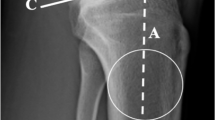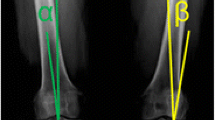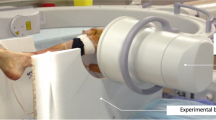Abstract
Purpose
Restoration of posterior tibial translation (PTT) after reconstruction of the posterior cruciate ligament (PCL) is deemed necessary to restore physiological knee kinematics. However, current surgical techniques have failed to show a complete reduction of posterior laxity. It was hypothesized that early postoperative PTT increases over time.
Methods
The study comprised of 46 patients (10 female, 36 male; 30 ± 9 years), who underwent PCL reconstruction in a single-surgeon series. Patients were evaluated by bilateral stress radiographs in a prospective manner preoperatively; at 3, 6, 12 and 24 months; and at a final follow-up (FFU) of at least 5 years. Covariants included age, gender, BMI, tibial slope (TS) and the number of operated ligaments. Two blinded observers reviewed all radiographs, evaluating the TS and the posterior tibial translation.
Results
All patients were evaluated at a mean final follow-up of 102 (range 65–187) months. Mean side-to-side difference of the PTT significantly improved from preoperative to 3-month postoperative values (10.9 ± 3.1 vs. 3.6 ± 3.8 mm; P < 0.0001). The PTT increased to 4.6 ± 3.7 mm at 6 months, to 4.8 ± 3.3 mm at 12 months, to 4.8 ± 3.2 mm at 24 months, to 5.4 ± 3.4 mm at FFU. Consequently, there was a significant increase of PTT between 3-month and final follow-up (3.6 ± 3.8 vs. 5.4 ± 3.4 mm; P = 0.02). Flattening of the TS resulted in a significantly higher PTT compared to subjects with a high TS at 24 months and FFU. There was no significant influence by BMI, age, gender and the number of operated ligaments.
Conclusions
Early results after PCL reconstruction seem promising as posterior tibial translation is significantly improved. However, there is a significant increase in PTT from early postoperative values to the final follow-up of at least 5 years. This is particularly notable in patients with flattening of the TS. As a consequence, surgeons and patients need to be aware that initial posterior stability should not be equated with the final outcome.
Level of evidence
Cohort study, Level III.





Similar content being viewed by others
References
Arnold MP, Lie DT, Verdonschot N, de Graaf R, Amis AA, van Kampen A (2005) The remains of anterior cruciate ligament graft tension after cyclic knee motion. Am J Sports Med 33:536–542
Barrett GR, Savoie FH (1991) Operative management of acute PCL injuries with associated pathology: long-term results. Orthopedics 14:687–692
Boynton MD, Tietjens BR (1996) Long-term followup of the untreated isolated posterior cruciate ligament-deficient knee. Am J Sports Med 24:306–310
Campbell RB, Torrie A, Hecker A, Sekiya JK (2007) Comparison of tibial graft fixation between simulated arthroscopic and open inlay techniques for posterior cruciate ligament reconstruction. Am J Sports Med 35:1731–1738
Ciccone WJ, Bratton DR, Weinstein DM, Elias JJ (2006) Viscoelasticity and temperature variations decrease tension and stiffness of hamstring tendon grafts following anterior cruciate ligament reconstruction. J Bone Jt Surg Am 88:1071–1078
Corsetti JR, Jackson DW (1996) Failure of anterior cruciate ligament reconstruction: the biologic basis. Clin Orthop Relat Res 325:42–49
Dejour H, Bonnin M (1994) Tibial translation after anterior cruciate ligament rupture. Two radiological tests compared. J Bone Jt Surg Br 76:745–749
Fanelli GC, Edson CJ (2004) Combined posterior cruciate ligament-posterolateral reconstructions with Achilles tendon allograft and biceps femoris tendon tenodesis: 2- to 10-year follow-up. Arthroscopy 20:339–345
Fanelli GC (2008) Posterior cruciate ligament rehabilitation: how slow should we go? Arthroscopy 24:234–235
Ferretti A, Conteduca F, Labianca L, Monaco E, De Carli A (2005) Evolgate fixation of doubled flexor graft in anterior cruciate ligament reconstruction biomechanical evaluation with cyclic loading. Am J Sports Med 33:574–582
Getelman MH, Friedman MJ (1999) Revision anterior cruciate ligament reconstruction surgery. J Am Acad Orthop Surg 7:189–198
Gill TJ, DeFrate LE, Wang C, Carey CT, Zayontz S, Zarins B, Li G (2004) The effect of posterior cruciate ligament reconstruction on patellofemoral contact pressures in the knee joint under simulated muscle loads. Am J Sports Med 32:109–115
Gwinner C, Weiler A, Roider M, Schaefer FM, Jung TM (2017) Tibial slope strongly influences knee stability after posterior cruciate ligament reconstruction. Am J Sports Med 45:355–361
Harner CD, Höher J (1998) Evaluation and treatment of posterior cruciate ligament injuries. Am J Sports Med 26:471–482
Harner CD, Janaushek MA, Kanamori A, Yagi M, Vogrin RM, Woo SL (2000) Biomechanical analysis of a double-bundle posterior cruciate ligament reconstruction. Am J Sports Med 28:144–151
Harvey AR, Thomas NP, Amis AA (2003) The effect of screw length and position on fixation of four-stranded hamstring grafts for anterior cruciate ligament reconstruction. Knee 10:97–102
Jackson DW, Grood ES, Cohn BT, Arnoczky SP, Simon TM, Cummings JF (1991) The effects of in situ freezing on the anterior cruciate ligament. An experimental study in goats. J Bone Jt Surg Am 73:201–213
Jacobsen K (1976) Stress radiographical measurement of the anteroposterior, medial and lateral stability of the knee joint. Acta Orthop Scand 47:335–344
Kim YM, Lee CA, Matava MJ (2011) Clinical results of arthroscopic single-bundle transtibial posterior cruciate ligament reconstruction: a systematic review. Am J Sports Med 39:425–434
Lin YC, Chen SK, Liu TH, Cheng YM, Chou PP (2013) Arthroscopic transtibial single-bundle posterior cruciate ligament reconstruction using patellar tendon graft compared with hamstring tendon graft. Arch Orthop Trauma Surg 133:523–530
Lipscomb AB, Anderson AF, Norwig ED, Hovis WD, Brown DL (1993) Isolated posterior cruciate ligament reconstruction Long-term results. Am J Sports Med 21:490–496
Logan M, Williams A, Lavelle J, Gedroyc W, Freeman M (2004) The effect of posterior cruciate ligament deficiency on knee kinematics. Am J Sports Med 32:1915–1922
MacGillivray JD, Stein BE, Park M, Allen AA, Wickiewicz TL, Warren RF (2006) Comparison of tibial inlay versus transtibial techniques for isolated posterior cruciate ligament reconstruction: minimum 2-year follow-up. Arthroscopy 22:320–328
Matava MJ, Ellis E, Gruber B (2009) Surgical treatment of posterior cruciate ligament tears: an evolving technique. J Am Acad Orthop Surg 17:435–446
Milano G, Mulas PD, Sanna-Passino E, Careddu GM, Ziranu F, Fabbriciani C (2005) Evaluation of bone plug and soft tissue anterior cruciate ligament graft fixation over time using transverse femoral fixation in a sheep model. Arthroscopy 21:532–539
Mook WR, Civitarese D, Turnbull TL, Kennedy NI, O’Brien L, Schoeberl JB, LaPrade RF (2016) Double-bundle posterior cruciate ligament reconstruction: a biomechanical analysis of simulated early motion and partial and full weightbearing on common reconstruction grafts. Knee Surg Sports Traumatol Arthrosc 8:2536–2544
Petrigliano FA, Suero EM, Voos JE, Pearle AD, Allen AA (2012) The effect of proximal tibial slope on dynamic stability testing of the posterior cruciate ligament- and posterolateral corner-deficient knee. Am J Sports Med 40:1322–1328
Pilia M, Murray M, Guda T, Heckman M, Appleford M (2015) Pretensioning of soft tissue grafts in anterior cruciate ligament reconstruction. Orthopedics 38:e582–e587
Prodromos CC, Hecker A, Joyce B, Finkle S, Shi K (2009) Elongation of simulated whipstitch post anterior cruciate ligament reconstruction tibial fixation after cyclic loading. Knee Surg Sports Traumatol Arthrosc 17:914–919
Race A, Amis AA (1998) PCL reconstruction. In vitro biomechanical comparison of ‘isometric’ versus single and double-bundled ‘anatomic’ grafts. J Bone Jt Surg Br 80:173–179
Scheffler SU, Südkamp NP, Göckenjan A, Hoffmann RF, Weiler A (2002) Biomechanical comparison of hamstring and patellar tendon graft anterior cruciate ligament reconstruction techniques: the impact of fixation level and fixation method under cyclic loading. Arthroscopy 18:304–315
Schulz MS, Steenlage ES, Russe K, Strobel MJ (2007) Distribution of posterior tibial displacement in knees with posterior cruciate ligament tears. J Bone Jt Surg Am 89:332–338
Sekiya JK, West RV, Ong BC, Irrgang JJ, Fu FH, Harner CD (2005) Clinical outcomes after isolated arthroscopic single-bundle posterior cruciate ligament reconstruction. Arthroscopy 21:1042–1050
Song EK, Park HW, Ahn YS, Seon JK (2014) Transtibial versus tibial inlay techniques for posterior cruciate ligament reconstruction: long-term follow-up study. Am J Sports Med 42:2964–2971
Strobel MJ, Weiler A, Schulz MS, Russe K, Eichhorn HJ (2003) Arthroscopic evaluation of articular cartilage lesions in posterior-cruciate-ligament-deficient knees. Arthroscopy 19:262–268
Wajsfisz A, Christel P, Djian P (2010) Does combined posterior cruciate ligament and posterolateral corner reconstruction for chronic posterior and posterolateral instability restore normal knee function? Orthop Traumatol Surg Res 96:394–399
Wang CJ, Chen HS, Huang TW (2003) Outcome of arthroscopic single bundle reconstruction for complete posterior cruciate ligament tear. Injury 34:747–751
Weiler A, Richter M, Schmidmaier G, Kandziora F, Südkamp NP (2001) The EndoPearl device increases fixation strength and eliminates construct slippage of hamstring tendon grafts with interference screw fixation. Arthroscopy 17:353–359
Weiler A, Peine R, Pashmineh-Azar A, Abel C, Südkamp NP, Hoffmann RF (2002) Tendon healing in a bone tunnel. Part I: Biomechanical results after biodegradable interference fit fixation in a model of anterior cruciate ligament reconstruction in sheep. Arthroscopy 18:113–123
Weiler A, Hoffmann RF, Bail HJ, Rehm O, Südkamp NP (2002) Tendon healing in a bone tunnel. Part II: Histologic analysis after biodegradable interference fit fixation in a model of anterior cruciate ligament reconstruction in sheep. Arthroscopy 18:124–135
Weinberg DS, Williamson DF, Gebhart JJ, Knapik DM, Voos JE (2016) Differences in medial and lateral posterior tibial slope an osteological review of 1090 tibiae comparing age, sex, and race. Am J Sports Med 1:106–113
Yang JH, Yoon JR, Jeong HI, Hwang DH, Woo SJ, Kwon JH, Nha KW (2012) Second-look arthroscopic assessment of arthroscopic single-bundle posterior cruciate ligament reconstruction: comparison of mixed graft versus achilles tendon allograft. Am J Sports Med 40:2052–2060
Acknowledgements
We would like to show our gratitude to Kevin C. Wang (Northwestern University Feinberg School of Medicine Chicago, IL, USA) for his constructive criticism and for his correction of the manuscript, which led to a significant improvement of the study.
Funding
All authors declare that they have not received any funding or research Grants in the course of study, research or assembly of the manuscript.
Author information
Authors and Affiliations
Contributions
All authors have seen and approved submission of the manuscript, and have taken due care to ensure the integrity of the work. CG: Data collection, Writing and editing the manuscript. TMJ: Data analysis, Revising the manuscript. IS: Data collection, Writing the manuscript. AW: Co-ordinated the study, Data collection, Writing the manuscript.
Corresponding author
Ethics declarations
Conflict of interest
The authors declare that they have no conflicts of interest in the authorship and publication of this contribution. More specifically, none of the authors received payments or services, either directly or indirectly (i.e., via his or her institution), from a third party in support of any aspect of this work. None of the authors, or their institution(s), had any financial relationship, with any entity in the biomedical arena that could be perceived to influence or have the potential to influence what is written in this work. In addition, all authors declare that they have had no other relationships, or have been engaged in any other activities, that could be perceived to influence or have the potential to influence what is written in this work.
Ethical approval
The ethics committee of Charité-Universitaetsmedizin Berlin approved the current study (EA1/003/16).
Informed consent
Informed consent was obtained from all individual participants included in the study.
Rights and permissions
About this article
Cite this article
Gwinner, C., Jung, T.M., Schatka, I. et al. Posterior laxity increases over time after PCL reconstruction. Knee Surg Sports Traumatol Arthrosc 27, 389–396 (2019). https://doi.org/10.1007/s00167-018-5035-y
Received:
Accepted:
Published:
Issue Date:
DOI: https://doi.org/10.1007/s00167-018-5035-y




